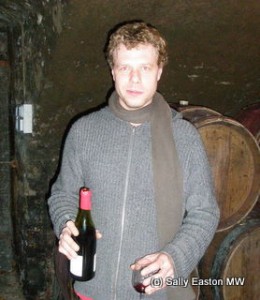Domaine Lapierre

Mathieu Lapierre
Having returned to the domaine in 2005 to work with his father, Mathieu Lapierre now runs this estate after the untimely death of his father Marcel in 2010.
From 1981, Marcel adopted a less interventionist way of growing his fruit and making wine, under the auspices of Jules Chauvet who is widely regarded as the father of what has become known as ‘natural wine’. Essentially, synthetic vineyard applications are avoided, as are industrial yeasts, enzymes, chaptalisation, and minimising the use of sulphur dioxide, eliminating its addition altogether in some cuvees. Mathieu said “we respect as much as possible what the terroir, and the vintage is, without adding anything. So we don’t kill the yeast before we want to use them”, with chemicals in the vineyard for example. But he does plough the vineyards, because, he said “vines are lazy. We make the roots go deep into the rocks to find what they need” to survive, by severing shallow lateral roots with the plough.
As some evidence for his viticultural approach, the 15 hectares of this estate are certified organic. Mathieu is also testing biodynamics on 3 hectares of this, and he keeps this wine separately to watch its evolution.
His vines all belong to the Morgon appellation. They average 45 years old and include a hectare on the climat of Côte du Py. The soils are all decomposed granite.
Mathieu uses traditional Beaujolais carbonic maceration to make his wines. Whole bunches only, with any individual bad berries discarded. If it’s hot the baskets of grapes will go into a cooling truck. The level of carbonic maceration “is not the winemaker’s choice” he said, “in 2009, it was 95% carbonic maceration because the fruit was dry. But you could have 30% juice and 70% carbonic maceration” depending on the conditions of the vintage.
The quality of the vintage also directs the length of maceration, which is anything from two to five weeks for Domaine Lapierre. Wines then go to large oak casks, and fourth fill and older Burgundy barrels, for about nine months.
Mathieu trained as a microbiologist to better understand the non-interventionist opportunities. He said “my father was one of the first in Beaujolais working on a green revolution in the 1970s. Marcel wanted to go back to a quality that was lacking, the way that people had done things for ever, using oenology as a tool, or as medicine.” Because he doesn’t add sulphites, acid, sugar, yeast, or use temperature control, “you need to control everything” he said. A lot of this is done by regular tasting at vintage, as well as knowing at a microbiological level what he’s able to avoid doing.
He makes half his bottling without sulphites, and the other half with around 25mg/l of SO2, and has noticed that “younger wine without sulphites can be better, but after a few years it can be the other way round.”
About 70% of his customers ask for his wines with sulphites, which, he said “make the wine clearer and straighter.”
Tasting, in situ, December 2011
Domaine Lapierre, Morgon 2010 (without sulphites), ~£20
Not hugely fragrant, but nicely smooth and textured. Sapid, graphite notes in a well-structured wine. Fresh with elements of steel. Delicious.
Domaine Lapierre, Morgon 2009 (without sulphites)
Graphite and dark, fresh, plums, smoky notes, something different, purple notes, fresh core and quite strong. Liquorice stick, savoury-fresh linear element.
Domaine Lapierre, Morgon 2009 (with sulphites)
Notably fruitier, but I don’t find it simpler. Has chalky fine tannin, and is packed with flavour.
Domaine Lapierre, Morgon 2005 (with sulphites)
Fresh, violet, soft-plum and rich fragrance. Sweet fruit.
Domaine Lapierre, Morgon 2005 (without sulphites)
Smoke, lead, graphite, more character, dimension and length. Vg.
My research trip to Beaujolais in December 2011 was sponsored by Inter Beaujolais.



